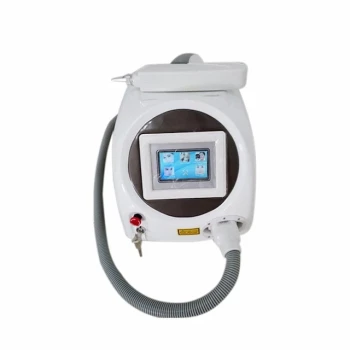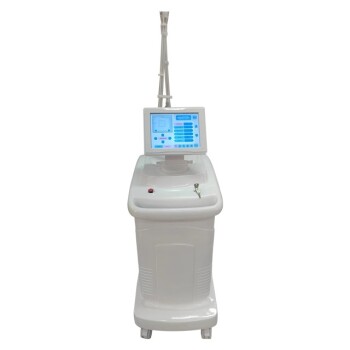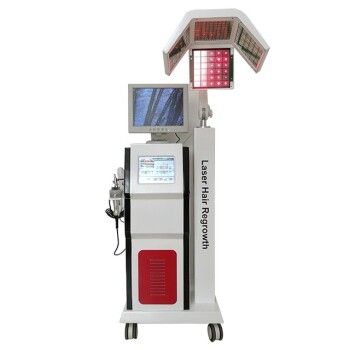At its core, the active material in an Nd:YAG laser is a carefully engineered composite. The true "active" component consists of neodymium (Nd) ions, which are responsible for producing the laser light. These ions are embedded within a larger, transparent host crystal of yttrium aluminum garnet (YAG), which provides the necessary structural and optical environment.
The key takeaway is not simply a material's name, but a functional partnership. The Nd:YAG laser works because of the synergy between a light-emitting "dopant" (Neodymium) and a stable "host" crystal (YAG) that holds it in the perfect configuration.
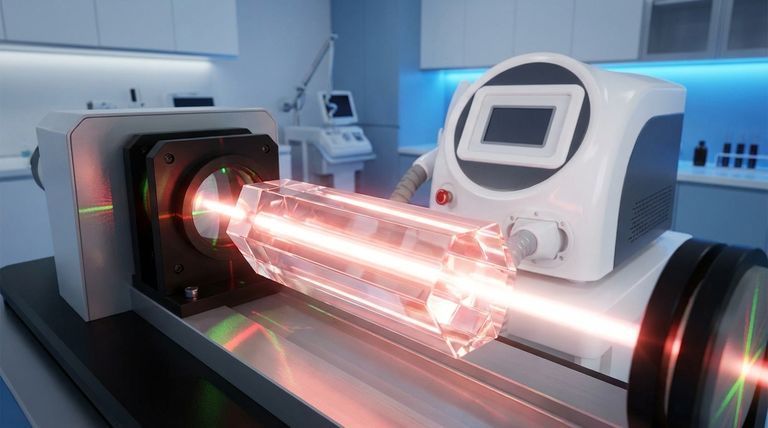
The Anatomy of an Nd:YAG Laser Crystal
To truly understand the active material, we must look at its two distinct components and the roles they play. The name "Nd:YAG" itself describes this relationship: Neodymium in Yttrium Aluminum Garnet.
The Host Crystal: Yttrium Aluminum Garnet (YAG)
YAG is a synthetic crystal, not a naturally occurring mineral. Think of it as the foundational scaffolding for the laser.
Its primary job is to provide a stable, orderly, and optically pure home for the neodymium ions. It does not produce light itself.
This material is chosen for its exceptional properties: it is very hard, has high thermal conductivity to dissipate waste heat, and is transparent to both the pump light and the laser light that is generated.
The Active Ion: Neodymium (Nd)
Neodymium is the element that actually performs the "lasing." It is the engine of the system.
These Nd ions are intentionally introduced into the YAG crystal as an impurity, a process known as doping.
When energized by an external power source (like a flashlamp or a laser diode), the electrons in the neodymium ions jump to a higher energy state. When they fall back down, they release that energy as photons of a very specific wavelength—most commonly 1064 nanometers.
How They Work Together: The Doping Process
During the crystal's manufacturing, a small percentage (typically around 1%) of the yttrium ions in the YAG crystal lattice are replaced by neodymium ions.
This precise substitution places the active Nd ions in a uniform, rigid structure. This arrangement is critical for producing a stable, high-quality laser beam.
Without the YAG host, the neodymium ions would not have the stable environment needed to lase efficiently. Without the neodymium dopant, the YAG crystal would be just a transparent block.
Why This Combination is So Effective
The pairing of Nd and YAG has remained a benchmark in solid-state lasers for decades due to a unique convergence of beneficial properties.
The Four-Level Energy System
The electron energy levels of Neodymium within the YAG host create a highly efficient four-level laser system.
In simple terms, this structure makes it much easier to achieve the "population inversion"—the condition where more ions are in an excited state than a ground state—which is required for lasing to begin.
This efficiency means Nd:YAG lasers can operate continuously with less input power compared to other designs, like three-level lasers.
Superior Thermal and Mechanical Properties
Laser generation is an inefficient process that creates significant waste heat. The high thermal conductivity of the YAG crystal allows it to pull this heat away from the core, preventing damage.
Its mechanical hardness also makes it durable and resistant to the physical stresses involved in high-power laser operation.
Wavelength Versatility
The primary 1064 nm output of an Nd:YAG laser is in the infrared spectrum, which is highly effective for industrial materials processing like cutting and welding.
Furthermore, this wavelength can be efficiently modified using secondary optics to produce other colors, such as green light (532 nm) for medical procedures or ultraviolet light for precision micromachining.
Understanding the Trade-offs
Despite its widespread use, the Nd:YAG system is not without limitations. Acknowledging them is key to understanding its place among other laser technologies.
Cost and Manufacturing Complexity
Growing large, optically perfect single-crystal YAG boules is a slow, energy-intensive, and expensive process. Any defects in the crystal can severely degrade the laser's performance.
Inherent Heat Generation
The energy difference between the pump photons and the emitted laser photons is lost as heat directly within the crystal. This "quantum defect" is a fundamental limit on efficiency and necessitates robust cooling systems for high-power models.
Competition from Fiber Lasers
In recent years, ytterbium-doped fiber lasers have become a major competitor, especially in industrial cutting and welding. Fiber lasers often offer better beam quality, higher electrical efficiency, and simpler cooling, though Nd:YAG remains dominant in applications requiring high pulse energy.
Applying This Knowledge
Your understanding of the Nd:YAG active material is most useful when placed in the context of a specific goal.
- If your primary focus is materials science: The key is the host-dopant interaction, where the YAG crystal lattice's properties dictate the performance of the embedded Nd ions.
- If your primary focus is laser applications: The key is that the Nd:YAG system is a reliable source of high-power 1064 nm infrared energy, ideal for thermal processing and convertible to other useful wavelengths.
- If your primary focus is fundamental physics: The key is recognizing Nd:YAG as a classic and highly efficient example of a four-level, solid-state laser system.
Understanding this fundamental partnership between the active ion and its crystalline host is the key to mastering the principles of modern solid-state lasers.
Summary Table:
| Component | Role | Key Property |
|---|---|---|
| Neodymium (Nd) Ions | Active Laser Medium | Emits light at 1064 nm when energized |
| Yttrium Aluminum Garnet (YAG) | Host Crystal | Provides stable, durable, and thermally conductive structure |
| Combined (Nd:YAG) | Complete Active Material | Enables efficient four-level lasing system for high-power applications |
Ready to Integrate Professional Nd:YAG Technology?
BELIS specializes in providing advanced medical aesthetic equipment, including high-performance Nd:YAG laser systems. Our solutions are engineered for reliability and superior results, empowering medical aesthetics clinics and premium beauty salons to enhance their service offerings and patient outcomes.
Discover how our expertise can benefit your practice. Contact our specialists today for a personalized consultation.
Visual Guide
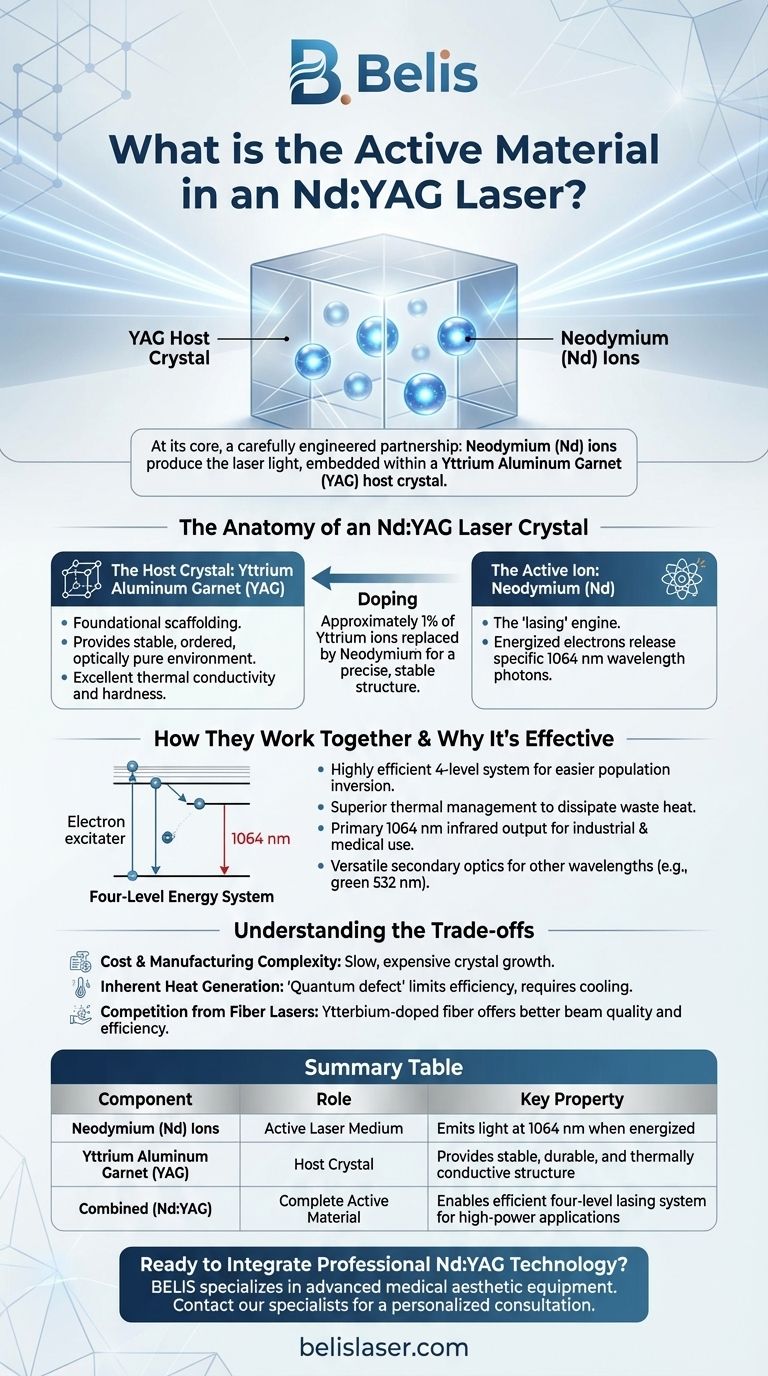
Related Products
- Q Switch Nd Yag Laser Machine Tattoo Removal Nd Yag Machine
- Clinic Use IPL and SHR Hair Removal Machine with Nd Yag Laser Tattoo Removal
- Diode Laser SHR Trilaser Hair Removal Machine for Clinic Use
- 7D 12D 4D HIFU Machine Device
- 22D HIFU Machine Device Facial Machine
People Also Ask
- What are Q-switched lasers commonly used for? Remove Tattoos & Pigment with Precision
- Is Q Switched Nd:YAG laser good? The Gold Standard for Tattoo & Pigment Removal
- How long does it take to recover from Nd:YAG laser treatment? A Timeline for Every Procedure
- Is Q-Switch laser safe for skin? Achieve Precise, Non-Invasive Skin Rejuvenation Safely
- How does the Nd:YAG laser work? Unlocking Deep-Tissue Precision for Medical Aesthetics
